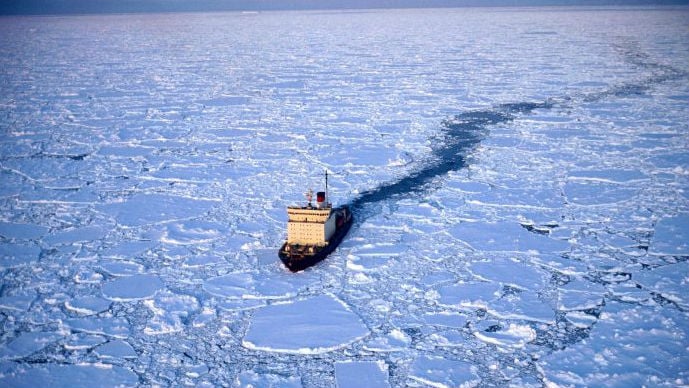FOOLS_NIGHTMARE
ELITE MEMBER

- Joined
- Sep 26, 2018
- Messages
- 18,063
- Reaction score
- 12
- Country
- Location
Ancient Cholistan, Archeology and Architecture has identified 410 extant sites in the desert, 370 of which are in the present day district of Bahawalpur, including the largest archeological remains at Ghanwerai Wala. These archeological sites are strewn with pottery shards which are visible from a distance due to the red hue of the remains. These sites date back to the different periods i.e. the Hakra Ware period (3800-3100 BCE), Early Harappan (3000-2500 BCE), Mature Harappan (2500- 2000BCE) and Late Harappan (1900-1500 BCE).
Not even a fraction of the dozens of sites in the Cholistan have been excavated sadly.

Amidst the sand dunes of Cholistan are the remains of another river that was once fed by annual monsoons and the Himalayan glaciers, the Hakra(Sarasvati), on whose banks the very ancient Indus Valley civilization once thrived. Also known as the Harappa (named after a nearby village) the culture remains an enigma. The Hakra, a miles-wide river that ran south of the Indus whose course is still visible from space, has been a dry river bed for the better part of three thousand years. Once the Indus Valley civilization itself collapsed circa 1900BC its cities eroded and their remains covered by (that old standby) the sands of time.

It was in 1826, that a British Army deserter, posing as an American engineer named Charles Masson, recorded the existence of mounded ruins at a small town in the Punjab, Pakistan. Archeological surveys undertaken in the mid-1800s led to the assumption that as the mounds were remnants of a recent culture it would be okay for the engineers constructing the Lahore-Multan railroad used brick from the ruins for track ballast. The bricks taken from the site were more than enough to furnish 100 miles of railway track, testifying to the scale of the buildings that existed there.

Thousands of years ago (as of last year determined by geologic survey and modern dating methods to be at least eight thousand years) the Indus Valley civilization was larger than the ancient civilizations of Egypt and Mesopotamia combined. Many of its sprawling cities were located on the banks of rivers that still flow through Pakistan. This culture once extended over more than 386,000 square miles (1 million square kilometers) across the plains of the Indus River from the Arabian Sea to the Ganges, and at its peak may have accounted for 10 percent of the world population. The cities were so sophisticated and well-planned, that many archaeologists believe they were conceived as a whole before construction on them begun. Lothar, a port city found in the 1950s, has the earliest known shipping docks.



Some of the pottery and artifacts found in nearby sites.






A hundred years ago ancient Egypt was all hidden under the sand along the Nile, one day the great cities of ancient Cholistan will be unearthed as well, all we need is a Howard Carter. The riches and artifacts of the Indus/Harappan civilization may surprise the world Inshallah.




Amidst the sand dunes of Cholistan are the remains of another river that was once fed by annual monsoons and the Himalayan glaciers, the Hakra(Sarasvati), on whose banks the very ancient Indus Valley civilization once thrived. Also known as the Harappa (named after a nearby village) the culture remains an enigma. The Hakra, a miles-wide river that ran south of the Indus whose course is still visible from space, has been a dry river bed for the better part of three thousand years. Once the Indus Valley civilization itself collapsed circa 1900BC its cities eroded and their remains covered by (that old standby) the sands of time.
It was in 1826, that a British Army deserter, posing as an American engineer named Charles Masson, recorded the existence of mounded ruins at a small town in the Punjab, Pakistan. Archeological surveys undertaken in the mid-1800s led to the assumption that as the mounds were remnants of a recent culture it would be okay for the engineers constructing the Lahore-Multan railroad used brick from the ruins for track ballast. The bricks taken from the site were more than enough to furnish 100 miles of railway track, testifying to the scale of the buildings that existed there.
Thousands of years ago (as of last year determined by geologic survey and modern dating methods to be at least eight thousand years) the Indus Valley civilization was larger than the ancient civilizations of Egypt and Mesopotamia combined. Many of its sprawling cities were located on the banks of rivers that still flow through Pakistan. This culture once extended over more than 386,000 square miles (1 million square kilometers) across the plains of the Indus River from the Arabian Sea to the Ganges, and at its peak may have accounted for 10 percent of the world population. The cities were so sophisticated and well-planned, that many archaeologists believe they were conceived as a whole before construction on them begun. Lothar, a port city found in the 1950s, has the earliest known shipping docks.
Some of the pottery and artifacts found in nearby sites.
A hundred years ago ancient Egypt was all hidden under the sand along the Nile, one day the great cities of ancient Cholistan will be unearthed as well, all we need is a Howard Carter. The riches and artifacts of the Indus/Harappan civilization may surprise the world Inshallah.





Attachments
Last edited:








